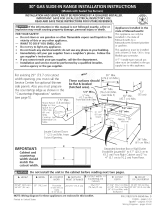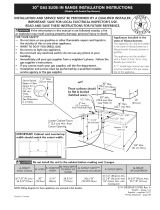
6
INSTALLATION PROCEDURE
CAUTION
LACERATION, FOREIGN OBJECT,
CRUSH HAZARD
• When installing, moving or servicing any appliance, wear proper
protective equipment, including cut resistant gloves, steel-toed
shoes and safety glasses.
IMPORTANT Failure to remove packaging materials could result
in damage to the appliance.
1
Remove all tape and packaging materials. Check for lm on
stainless steel parts, padding/spacers on and around door and
face of oven, cardboard and plastic on and around racks, inside
storage drawer, etc.
Do not use sharp instruments, rubbing alcohol, ammable uids
or abrasive cleaners to remove tape or glue. These products can
damage the surface of your range.
2
Inventory all loose parts against the PARTS INCLUDED chart
on page 2.
Check for shipping damage and/or missing parts. Report any
damaged and/or missing parts to your local retailer.
3
To reduce the weight of the range while being moved, adjusted
and installed, set aside cooktop grates, cooktop burners, oven
racks and any other accessories until the unit is installed and
ready for use.
During installation, service, gas conversion and leveling, it is
recommended to remove the oven door and drawer. See the
Operation Manual for instructions on removing the oven door
and drawer.
OPTIONAL CONVERSIONS
LP GAS CONVERSION
WARNING
BURN, FIRE HAZARD
Failure to properly convert the range to the fuel type used at the
installation site can result in increased risk of re, burn injuries and
property damage. The conversion must be performed by a qualied
service technician in accordance with the manufacturer's instruc-
tions and all local codes and requirements. The agency performing
this work assumes responsibility for the conversion.
The Slide-In Gas Range is preset for use with Natural Gas and can
be converted for use with Propane (LP). Conversion for use with
propane must be performed by a qualied technician in accordance
with the installation instructions and local codes. The agency per-
forming this conversion assumes responsibility for the conversion
to propane use.
HIGH ALTITUDE CONVERSION
WARNING
CARBON MONOXIDE HAZARD
Reduced air pressure and oxygen availability at high altitudes may
affect proper burner combustion. Failure to properly convert the
range for high altitude installations can result in increased risk
carbon monoxide. The conversion must be performed by a qualied
service technician in accordance with the manufacturer's instruc-
tions and all local codes and requirements. The agency performing
this work assumes responsibility for the conversion.
Units must be converted for proper operation at elevations in excess
of 6,000 feet. Contact a Sharp dealer to request a High Altitude
Conversion Kit. High altitude conversion requires all cooktop and
oven burner orices to be changed. Follow detailed instructions
included with the conversion kit. The reg ulator must be set according
to the fuel type in use at the installation site.
ANTI-TIP BRACKET
WARNING
TIP OVER HAZARD
• A child or adult can tip the range and be injured or killed. Verify
the anti-tip device has been properly installed and engaged per
installation instructions. Ensure the anti-tip device is re-engaged
when the range is moved.
• Do not operate the range without the anti-tip device in place and
engaged. Failure to follow this precaution can result in death or
serious burns to children or adults. Do not remove the leveling
legs. Doing so will prevent the range from being secured by the
anti-tip device.
To reduce the risk of tipping of the range, the range must be secured
to the oor by the properly installed Anti-Tip Bracket and screws
packed with the range. Failure to install the Anti-Tip Bracket will
allow the range to tip over if excessive weight is placed on an open
door or if child climbs upon it. Serious injury might result from
spilled hot liquids or from the range itself.
TO INSTALL ANTI-TIP BRACKET
1
Using the template provided with the Anti-Tip Bracket, locate
the installation area of the Anti-Tip Bracket. The Anti-Tip
Bracket may be installed at either the back-left or back-right
corner of the installation space, and only one Anti-Tip Bracket
is necessary.
2
Mark the location of the screws for the Anti-Tip Bracket.
3
Attach the Anti-Tip Bracket to the oor or wall.
Wood Construction Installation: Drill a 1/8" pilot hole where
screws are to be located. If bracket is to be mounted to the wall,
drill pilot hole at an approximate 20° downward angle. Screw must
enter wood.
Masonry Construction Installation: Due to the variety of masonry
materials that may be present at installation site, hardware is not
provided for attaching the Anti-Tip Bracket to masonry. If the
bracket is to be mounted to masonry or ceramic oors, attach using
two 5/16" OD sleeve anchors (with 1/4" bolt, either hex bolt head or
hex nut head) rated for minimum 300 lb tension for the masonry
material present at installation site.













